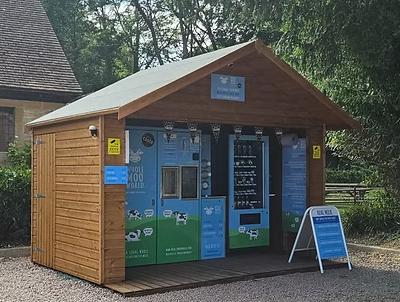The Revival of Local Milk Farms Across the UK
Across the British countryside, local milk farms are experiencing a remarkable resurgence. As more consumers prioritise traceability, freshness, and ethical sourcing, small-scale dairies are once again becoming the backbone of Britain’s dairy supply chain.
According to DEFRA, the number of small, direct-selling dairy farms rose by 11% between 2021 and 2024, a trend fuelled by growing demand for natural, unprocessed milk. These farms often operate on pasture-based systems, allowing cows to graze freely and yield higher quality milk.
From Shropshire to Somerset, farmers are finding renewed relevance by offering not only fresh dairy but also opportunities for communities to engage with food provenance.
The Benefits of Non-Homogenised Milk
One of the most sought-after products from these farms is non homogenised milk. Unlike the standard supermarket variety, this milk has not undergone the industrial homogenisation process that breaks down fat molecules. Instead, it retains a creamier texture, natural flavour, and fuller nutritional profile.
Studies published in the British Journal of Nutrition suggest that non-homogenised milk maintains better omega-3 fatty acid integrity, making it a healthier choice. For lactose-sensitive individuals, some report that non-homogenised milk is easier to digest due to its natural fat distribution and minimal processing.
Convenience Meets Freshness: The Rise of Milk Vending Machines
As consumers increasingly seek ways to access local, fresh milk outside of traditional shop hours, the milk vending machine has become a modern-day solution rooted in traditional values. These 24/7, self-service dispensers provide freshly chilled farm milk, often unhomogenised and pasteurised on-site.
Data from The Milk Station Company indicates that there are now over 800 active milk vending machines across the UK, with significant uptake in counties like Gloucestershire, Herefordshire, and Worcestershire.
These machines offer:
- Contactless payment for ease and hygiene
- Refillable glass bottles to reduce plastic waste
- Farm-fresh milk usually within 24 hours of milking
Some even include options to add milkshake flavours or to purchase related dairy products like butter and cream.
Local Milk Farms: Community-Supported and Environmentally Friendly
Buying from local milk farms offers more than just a delicious bottle of milk—it supports rural economies and sustainable practices. Local dairy farms typically:
- Keep food miles to a minimum
- Maintain smaller herds for higher animal welfare
- Employ regenerative farming techniques
Benefit
Local Milk Farms
Supermarket Milk
Food Miles
Often < 10 miles
Often > 100 miles
Processing
Lightly pasteurised or raw, non-homogenised
Ultra-pasteurised and homogenised
Packaging
Refillable glass bottles
Plastic, non-recyclable cartons
Support to Farmer
Direct to producer
Margin lost to middlemen
This table highlights why supporting your local dairy farm isn’t just about milk—it’s about values, sustainability, and quality.
Sweet Treats Vending: A Perfect Complement to Fresh Milk
Many milk vending sites are now expanding to include sweet treats vending alongside dairy offerings. These vending machines stock locally baked cakes, biscuits, flapjacks, and even artisanal chocolate—perfectly paired with a cold bottle of fresh milk.
In a recent survey by The Tuckshop Co., 68% of milk vending customers said they were more likely to buy snacks on-site if sweet options were available. This combination caters to impulse buys and turns milk stops into mini-local food experiences.
Popular sweet treats available in vending machines include:
- Shortbread biscuits made with local butter
- Brownies and traybakes from regional bakeries
- Homemade fudge using farm-fresh cream
Not only does this benefit other local businesses, but it also enhances the customer experience and increases revenue for farm-based vending sites.
Finding a Milk Vending Machine Near You
With the rise of digital tools, locating a milk vending machine in your area has never been easier. Websites like “Find Me a Milk Station” and apps such as “MilkMate” let users discover nearby machines based on postcode, product availability, or opening hours.
These platforms often allow reviews, show refill times, and display the provenance of the milk offered. Some vending locations also host social media pages for updates on stock, special offers, and farm events.
Why It Matters: The Bigger Picture
The revival of local milk supply chains and vending options is part of a broader shift towards responsible consumerism. Shoppers are demanding better:
- Better transparency
- Better treatment of animals
- Better food quality
This local-first model is not just a novelty—it's a solution to many of the food industry’s challenges. From lowering environmental impact to improving community resilience, these initiatives provide lasting value.
Conclusion: Reconnect With Real Food Through Local Vending Options
In a world where food systems are increasingly industrialised and disconnected, local milk farms and their milk vending machines offer a refreshing, real alternative. By choosing non homogenised milk from nearby dairies and exploring sweet treats vending, you're not just making a healthy and delicious choice—you’re helping to build a more sustainable and supportive food network.
Whether you're looking to reduce plastic, support local producers, or simply enjoy the natural taste of fresh dairy, these machines and farms are the answer. As vending technology continues to evolve, the accessibility of farm-fresh food will only increase.





Comments